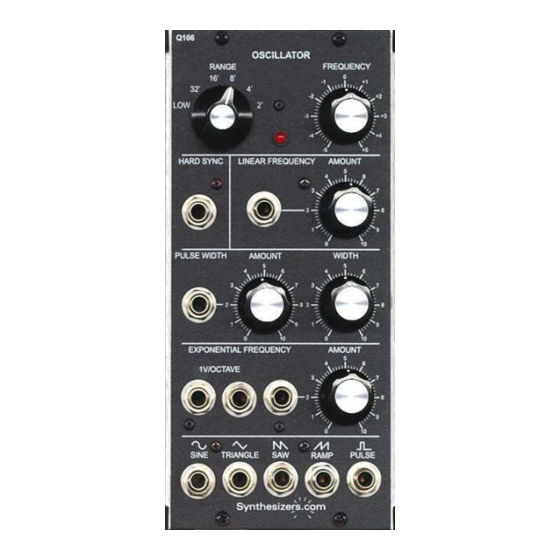
Advertisement
Quick Links
Q106
Oscillator
The Q106 Oscillator is the foundation of any synthesizer providing the basic
waveforms used to construct sounds. With a total range of .05hz to 20kHz+,
the Q106 operates as a powerful audio oscillator and a full-featured LFO.
The frequency (pitch) of the oscillator is controlled manually, by voltages
from other modules, and by voltages from controllers such as keyboards.
Both linear and standard 1-volt-per-octave exponential voltage inputs are
provided - each scalable by panel controls.
Five waveforms are available simultaneously - Sine, Triangle, Sawtooth,
Ramp and Pulse. The Pulse waveform is adjustable manually and may be
modulated via external voltage control.
A Hard-Sync input allows synchronization between oscillators.
Controls and Connectors
There are 6 sections (listed top to bottom)
- Frequency Range Section
- Hard Sync Section
- Linear Frequency Control Section
- Pulse Width Control Section
- Exponential Frequency Control Section
- Output Section
Frequency Range Section
Frequency Range Control
Selects octaves from 32hz to 512hz with a 'low' setting for
modulations.
Frequency Control
Allows fine control of pitch over 1 octave.
Hard Sync Section
Hard Sync Connector
Allows the oscillator to be syncronized with other oscillators to
prevent beating and to create strange effects.
Linear Frequency Control Section
Linear Frequency Control Connector
Allows external control of pitch with a linear response.
Linear Frequency Level Control
Determines the amount of affect that the linear control voltage has
upon pitch.
Jun 2014
Advertisement

Summary of Contents for Synthesizers.com Q106
- Page 1 Oscillator Jun 2014 The Q106 Oscillator is the foundation of any synthesizer providing the basic waveforms used to construct sounds. With a total range of .05hz to 20kHz+, the Q106 operates as a powerful audio oscillator and a full-featured LFO.
- Page 2 Q106 Oscillator Jun 2014 Range Switch Fine frequency Low=LFO rates adjustment +/- 1/2 octave Hard Sync input Linear Use Saw from input adjust another oscillator Pulse width Manual pulse modulation width adjust input 1V/Octave variable voltage control 1V/Octave inputs input adjust...
- Page 3 Q106 Oscillator Jun 2014 Pulse Width Control Section Pulse Width Control Connector Allows external control of pulse width. Pulse Width Level Control Determines the amount of affect that the pulse width control voltage has. Pulse Width Control Allows manual setting of pulse width.
- Page 4 Pulse Waveform Duty Cycle: 5% to 95% Q141 Oscillator Aid Use the Q141 aid module next to your Q106 oscillator for additional functionality including a soft sync input with amount control, waveform selector, amplitude adjustment, and inverted outputs. Tracking Accuracy Tracking accuracy determines how closely your oscillators track the keyboard.
- Page 5 Using the Oscillator to Modulate The Q106 Oscillator is designed to produce both audio signals and slow moving signals to modulate other modules. Normally this will be done using the 'Low' range which will give you frequencies below 32hz.
-
Page 6: Pc Board Layout
Q106 Oscillator Jun 2014 Calibration and Testing 1. Apply power for 10 minutes to warm up circuit. 2. Attach a frequency counter to the Sine output. 3. Attach a voltage calibrator to the far left 1V/Octave input. 4. Set the frequency Range knob on the front panel to 32' and the frequency knob to center (0).







Need help?
Do you have a question about the Q106 and is the answer not in the manual?
Questions and answers